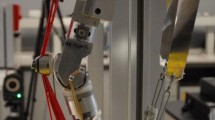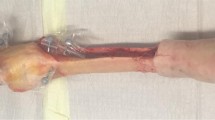Abstract
Even though posterior substituting total knee arthroplasty has been widely used in surgery, how the cam–post mechanism (posterior substituting mechanism) affects knee joint kinematics and function in patients is not known. The objective of the present study was to investigate posterior femoral translation, internal tibial rotation, tibiofemoral contact, and cam–post engagement of total knee arthroplasty patients during in vivo weight-bearing flexion. Twenty-four knees with a PS TKA were investigated while performing a single leg weight-bearing lunge from full extension to maximum flexion as images were recorded using a dual fluoroscopic system. The in vivo knee position at each targeted flexion angle was reproduced using 3D TKA models and the fluoroscopic images. The kinematics of the knee was measured from the series of the total knee arthroplasty models. The cam–post engagement was determined when the surface model of the femoral cam overlapped with that of the tibial post. The mean maximum flexion angle for all the subjects was 112.5 ± 13.1°. The mean flexion angle where cam–post engagement was observed was 91.1 ± 10.9°. The femur moved anteriorly from 0° to 30° and posteriorly through the rest of the flexion range. The internal tibial rotation increased approximately 6° from full extension to 90° of flexion and decreased slightly with further flexion. Both the medial and lateral contact point moved posteriorly from 0° to 30°, remained relatively constant from 30° to 90°, and then moved further posterior from 90° to maximum flexion. The in vivo cam–post engagement corresponded to increased posterior translation and reduced internal tibial rotation at high flexion of the posterior substituting total knee arthroplasty. The initial cam–post engagement was also mildly correlated with the maximum flexion angle of the knee (R = 0.51, p = 0.019). A later cam–post engagement might indicate an environment conducive to greater flexion. If the factors that affect cam–post engagement timing can be established, proper manipulation of those factors may improve the function of the knee after posterior substituting total knee arthroplasty.






Similar content being viewed by others
References
Aglietti P, Baldini A, Buzzi R, Lup D, De Luca L (2005) Comparison of mobile-bearing and fixed-bearing total knee arthroplasty: a prospective randomized study. J Arthroplasty 20:145–153
Anouchi YS, McShane M, Kelly F Jr, Elting J, Stiehl J (1996) Range of motion in total knee replacement. Clin Orthop Relat Res 331:87–92
Argenson JN, Scuderi GR, Komistek RD, Scott WN, Kelly MA, Aubaniac JM (2005) In vivo kinematic evaluation and design considerations related to high flexion in total knee arthroplasty. J Biomech 38:277–284
Asano T, Akagi M, Tanaka K, Tamura J, Nakamura T (2001) In vivo three-dimensional knee kinematics using a biplanar image-matching technique. Clin Orthop 388:157–166
Banks SA, Markovich GD, Hodge WA (1997) In vivo kinematics of cruciate-retaining and -substituting knee arthroplasties. J Arthroplasty 12:297–304
Capeci CM, Brown EC 3rd, Scuderi GR, Scott WN (2006) Component asymmetry in simultaneous bilateral total knee arthroplasty. J Arthroplasty 21:749–753
Catani F, Fantozzi S, Ensini A, Leardini A, Moschella D, Giannini S (2006) Influence of tibial component posterior slope on in vivo knee kinematics in fixed-bearing total knee arthroplasty. J Orthop Res 24(4):581–587
Delp SL, Kocmond JH, Stern SH (1995) Tradeoffs between motion and stability in posterior substituting knee arthroplasty design. J Biomech 28:1155–1166
Dennis DA, Komistek RD, Colwell CE Jr, Ranawat CS, Scott RD, Thornhill TS, Lapp MA (1998) In vivo anteroposterior femorotibial translation of total knee arthroplasty: a multicenter analysis. Clin Orthop 356:47–57
Dennis DA, Komistek RD, Mahfouz MR (2003) In vivo fluoroscopic analysis of fixed-bearing total knee replacements. Clin Orthop Relat Res 410:114–130
Dennis DA, Komistek RD, Stiehl JB, Walker SA, Dennis KN (1998) Range of motion after total knee arthroplasty: the effect of implant design and weight-bearing conditions. J Arthroplasty 13:748–752
Emmerson KP, Moran CG, Pinder IM (1996) Survivorship analysis of the kinematic stabilizer total knee replacement: a 10- to 14-year follow-up. J Bone Joint Surg Br 78:441–445
Fantozzi S, Catani F, Ensini A, Leardini A, Giannini S (2006) Femoral rollback of cruciate-retaining and posterior-stabilized total knee replacements: in vivo fluoroscopic analysis during activities of daily living. J Orthop Res 24:2222–2229
Hanson GR, Suggs JF, Freiberg AA, Durbhakula S, Li G (2006) Investigation of in vivo 6DOF total knee arthoplasty kinematics using a dual orthogonal fluoroscopic system. J Orthop Res 24:974–981
Huang HT, Su JY, Wang GJ (2005) The early results of high-flex total knee arthroplasty: a minimum of 2 years of follow-up. J Arthroplasty 20:674–679
Kim YH, Sohn KS, Kim JS (2005) Range of motion of standard and high-flexion posterior stabilized total knee prostheses. A prospective, randomized study. J Bone Joint Surg Am 87:1470–1475
Lee SY, Matsui N, Kurosaka M, Komistek RD, Mahfouz M, Dennis DA, Yoshiya S (2005) A posterior-stabilized total knee arthroplasty shows condylar lift-off during deep knee bends. Clin Orthop Relat Res 435:181–184
Li G, Most E, Otterberg E, Sabbag K, Zayontz S, Johnson T, Rubash H (2002) Biomechanics of posterior-substituting total knee arthroplasty: an in vitro study. Clin Orthop 404:214–225
Li G, Most E, Sultan PG, Schule S, Zayontz S, Park SE, Rubash HE (2004) Knee kinematics with a high-flexion posterior stabilized total knee prosthesis: an in vitro robotic experimental investigation. J Bone Joint Surg Am 86-A:1721–1729
Li G, Papannagari R, Nha KW, DeFrate LE, Gill TJ, Rubash HE (2007) The six degrees-of-freedom in-vivo kinematics of the knee: the coupling of the femoral and patellar kinematics. J Biomech Eng (accepted)
Li G, Suggs J, Hanson G, Durbhakula S, Johnson T, Freiberg A (2006) Three-dimensional tibiofemoral articular contact kinematics of a cruciate-retaining total knee arthroplasty. J Bone Joint Surg Am 88:395–402
Moro-Oka TA, Muenchinger M, Canciani JP, Banks SA (2006) Comparing in vivo kinematics of anterior cruciate-retaining and posterior cruciate-retaining total knee arthroplasty. Knee Surg Sports Traumatol Arthrosc 15:93–99
Papannagari R, DeFrate LE, Nha KW, Moses JM, Moussa M, Gill TJ, Li G (2007) Function of posterior cruciate ligament bundles during in-vivo knee flexion. Am J Sports Med 35(9):1507–1512
Piazza SJ, Delp SL, Stulberg SD, Stern SH (1998) Posterior tilting of the tibial component decreases femoral rollback in posterior-substituting knee replacement: a computer simulation study. J Orthop Res 16:264–270
Ranawat CS, Luessenhop CP, Rodriguez JA (1997) The press-fit condylar modular total knee system. Four-to-six-year results with a posterior-cruciate-substituting design. J Bone Joint Surg Am 79:342–348
Ritter MA, Harty LD, Davis KE, Meding JB, Berend ME (2003) Predicting range of motion after total knee arthroplasty. Clustering, log-linear regression, and regression tree analysis. J Bone Joint Surg Am 85-A:1278–1285
Seon JK, Song EK, Lee JY (2005) Comparison of range of motion of high-flexion prosthesis and mobile-bearing prosthesis in total knee arthroplasty. Orthopedics 28:s1247–1250
Uvehammer J, Karrholm J, Brandsson S (2000) In vivo kinematics of total knee arthroplasty. Concave versus posterior-stabilised tibial joint surface. J Bone Joint Surg Br 82:499–505
Victor J, Banks S, Bellemans J (2005) Kinematics of posterior cruciate ligament-retaining and -substituting total knee arthroplasty: a prospective randomised outcome study. J Bone Joint Surg Br 87-B:646–655
Acknowledgments
This work was supported by a research grant from Zimmer Inc. Guidance from Dr. Harry Rubash and Dr. Andrew Freiberg and the technical assistance of Dr. Jae Sik Park and Dr. Jung Soo Oh are greatly appreciated.
Author information
Authors and Affiliations
Corresponding author
Rights and permissions
About this article
Cite this article
Suggs, J.F., Hanson, G.R., Park, S.E. et al. Patient function after a posterior stabilizing total knee arthroplasty: cam–post engagement and knee kinematics. Knee Surg Sports Traumatol Arthr 16, 290–296 (2008). https://doi.org/10.1007/s00167-007-0467-9
Received:
Accepted:
Published:
Issue Date:
DOI: https://doi.org/10.1007/s00167-007-0467-9




